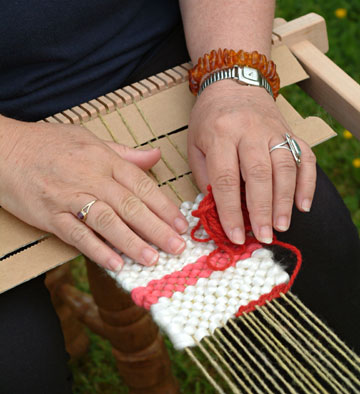How To Weave
The equipment used for weaving is called a loom.
Looms vary from simple frames to complicated machinery.
It is now possible to link a loom to a computer to make the patterns more quickly.
Principles of Weaving
The principles of weaving are very simple. One set of yarn threads are stretched on the loom. They are called the
WARP
For the warp thread choose a strong yarn that doesn’t break easily. Cotton rug warp is ideal but wool will work as long as it is firmly spun.
Another set are woven over one thread, under one thread, over the next, under the next and so on until the end of the row.
They are called the
WEFT
The next row, the weft threads are woven so that if they went over the warp on the first row, they go under it on the second row, and vice versa.
Children (and adults) love to experiment with weft threads, trying out colours, textures and add-ons such as grasses, sticks and seaweed - anything that forms a “thread”.
By the time three rows are woven, a cloth begins to form: this is called the
WEB
By changing the colour of the threads in both directions, patterns are formed.
Patterns are also formed by changing the over-under sequence, for instance, going under and over two threads instead of one.
This is the basis of all weaving, no matter how complicated the equipment.
GETTING STARTED
To “warp up” or thread the loom:
-
Measure to find the centre of the loom.
For the first weave, warp up 12 threads.This is a good width for beginners to learn the basic techniques.
It also allows them to finish the first piece quite quickly, which is very satisfying and helps to build confidence.
-
Count six grooves to the left of centre at the top of the loom and tie the yarn firmly round that groove
-
Take the yarn down to the bottom of the loom and hook it round the corresponding groove to the next one, then bring the yarn back up to the top of the loom and continue until you have 12 threads.
Tie the yarn firmly to the top on the 12th groove and the loom is ready to weave.
-
Weave in a strip of wood or cardboard. In the next row weave in a second strip, using the opposite sequence of threads , i.e. if you went over the first thread and under the second in the first row, reverse this and go under the first thread and over the second in the second row.
It is important to establish this weaving sequence carefully in the first few rows so that you can see how the pattern develops and there are no mistakes in the beginning.
After a few rows it becomes easier to see which thread goes over and which under.
You can weave in more sticks or cardboard to give you a bigger fringe when the piece is finished which is why the photo below has three!
Once you’ve woven in a base of either sticks or cardboard, it’s time to choose the yarns with which to design your piece.
I usually ask the pupils or students to choose three colours of yarn which they think look good together. This sparks off discussion about design and colour and is a great way to initiate the creative process.

The Materials
Weaving on a small frame is an excellent way to use leftover yarns and to experiment with recycling materials such as plastic shopping bags.
It is important in this first weaving to choose yarns which are at least as thick as Aran wool, especially when working with small children.
It is easier to manipulate the warp threads and to see the sequence of the weave when the yarn is thicker.
The piece also grows quite quickly which is encouraging for beginners to see the results.
Once the colours have been chosen show the pupils how to wind the wool loosely around their hands a few times to make simple tapestry “butterflies”.
For the first row, weave the opposite of the last stick or cardboard strip with the butterfly going over & under.
Pull the butterfly gently through until there is a 2 inch (5 cm) “tail” at the end. Wind the “tail” round the two end warp threads and then pull to the front. It can be left there until the piece is finished and then trimmed off.